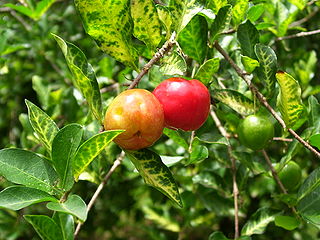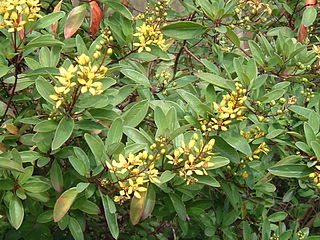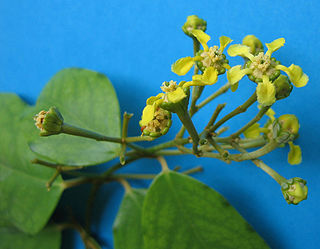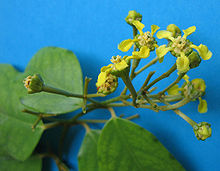
The Clusiaceae or GuttiferaeJuss. (1789) are a family of plants including 13 genera and ca 750 species. Several former members of Clusiacae are now placed in Calophyllaceae and Hypericaceae. They are mostly trees and shrubs, with milky sap and fruits or capsules for seeds. The family is primarily tropical. More so than many plant families, it shows large variation in plant morphology. According to the APG III, this family belongs to the order Malpighiales.

Leona Valley is a census-designated place located in the geographic Leona Valley of northern Los Angeles County, California, in the transition between the Sierra Pelona Mountains and Mojave Desert, just west of Palmdale and the Antelope Valley. The population was 1,607 at the 2010 census.

Carl Sigismund Kunth, also Karl Sigismund Kunth or anglicized as Charles Sigismund Kunth, was a German botanist. He is known for being one of the first to study and categorise plants from the American continents, publishing Nova genera et species plantarum quas in peregrinatione ad plagam aequinoctialem orbis novi collegerunt Bonpland et Humboldt.

August Heinrich Rudolf Grisebach was a German botanist and phytogeographer. He was born in Hannover on 17 April 1814 and died in Göttingen on 9 May 1879.

Malpighia is a genus of flowering plants in the nance family, Malpighiaceae. It contains about 45 species of shrubs or small trees, all of which are native to the American tropics. The generic name honours Marcello Malpighi, a 17th-century Italian physician and botanist. The species grow to 1–6 m (3.3–19.7 ft) tall, with a dense, often thorny crown. The leaves are evergreen, simple, 0.5–15 cm (0.20–5.91 in) long, with an entire or serrated margin. The flowers are solitary or in umbels of two to several together, each flower 1–2 cm (0.39–0.79 in) diameter, with five white, pink, red, or purple petals. The fruit is a red, orange, or purple drupe, containing two or three hard seeds. M. emarginata is cultivated for its sweet and juicy fruits, which are very rich in vitamin C.

Malpighiaceae is a family of flowering plants in the order Malpighiales. It comprises about 73 genera and 1315 species, all of which are native to the tropics and subtropics. About 80% of the genera and 90% of the species occur in the New World and the rest in the Old World.

Archaeoprepona demophon, the one-spotted prepona, banded king shoemaker, or demophon shoemaker is a butterfly belonging to the family Nymphalidae.
Adelphia is a genus in the Malpighiaceae, a family of about 75 genera of flowering plants in the order Malpighiales. Adelphia comprises four species of woody vines native to the West Indies, Mesoamerica, and western South America.

Byrsonima is one of about 75 genera in the Malpighiaceae, a family of flowering plants in the order Malpighiales. In particular in American English, they are known as locustberries. Another widely seen common name is serrets or serrettes.
Malpighiodes is a genus in the Malpighiaceae, a family of about 75 genera of flowering plants in the order Malpighiales. Malpighiodes comprises 4 species of woody vines native to northern South America.
Thryallis is a genus in the family Malpighiaceae, of scandent shrubs and woody vines native to Brazil and adjacent Paraguay and Bolivia.

Galphimia is a genus in the Malpighiaceae, a family of about 75 genera of flowering plants in the order Malpighiales; the name is an anagram of Malpighia.Galphimia comprises 26 species of large herbs, shrubs, and treelets. Twenty-two species occur in Mexico, one extending into Texas and one ranging to Nicaragua; four species occur in South America, south of the Amazon Basin. Galphimia gracilis is widely cultivated in warm regions throughout the world. Eight species are distinctive in that the petals become stiff and papery, and persist past the stage of fruit maturation.

Hiraea is a genus in the Malpighiaceae, a family of about 75 genera of flowering plants in the order Malpighiales. Hiraea comprises over 55 species of woody vines and shrubs found in diverse habitats, except very dry vegetation types, in the New World tropics and subtropics from western Mexico to Paraguay and adjacent Argentina and southeastern Brazil; it also occurs in the Lesser Antilles in Grenada and St. Lucia.

Mascagnia is a genus in the Malpighiaceae, a family of about 75 genera of flowering plants in the order Malpighiales. The genus Mascagnia comprises about 45 species that occur in diverse habitats from northern Mexico and the Caribbean to northern Argentina and south-eastern Brazil.
Spachea is a genus in the Malpighiaceae, a family of about 75 genera of flowering plants in the order Malpighiales. Spachea comprises 6 species of shrubs and trees growing in wet forests. One species occurs in Cuba, 2 species in southern Central America with one of those also in adjacent Colombia, and 3 species in northern South America. Spachea correae, native to Costa Rica and Panama, is listed in the IUCN Red List of Threatened Species.

Stigmaphyllon is a genus in the Malpighiaceae, a family of about 75 genera of flowering plants in the order Malpighiales. Amazonvine is a common name for species in this genus.
Excentradenia is a genus of plants in the family Malpighiaceae. Excentradenia comprises four species of woody vines native to the forests of northern South America.
Cottsia is a genus in the Malpighiaceae, a family of about 75 genera of flowering plants in the order Malpighiales. Cottsia comprises 3 species of slender twining vines native to northern Mexico and extending into Texas, New Mexico, and Arizona. The species of Cottsia were formerly included in Janusia, a genus of South America.

Heteropterys chrysophylla is a plant species that grows in South America and can be found from Brazil to Argentina.
Dicella is a genus in the Malpighiaceae, a family of about 75 genera of flowering plants in the order Malpighiales. Dicella includes seven species, assigned to two sections. Section Dicella comprises D. bracteosa and D. nucifera, found in southeastern Brazil and adjacent Paraguay and Argentina. Section Macropterys includes D. aciculifera, known only from Costa Rica, and D. conwayi, D. julianii, D. macroptera, and D. oliveirae, all of South America from Colombia south to about 19°S













